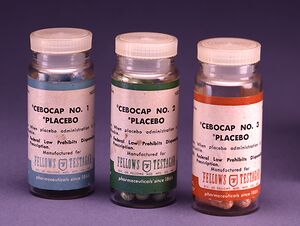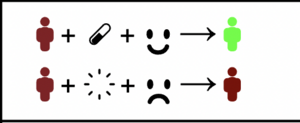Placebo Effect: Difference between revisions
No edit summary |
No edit summary |
||
| Line 30: | Line 30: | ||
* Manual therapists may strengthen the treatment effects of evidence-based interventions when they embrace the placebo response.<ref name=":0" /> | * Manual therapists may strengthen the treatment effects of evidence-based interventions when they embrace the placebo response.<ref name=":0" /> | ||
== Resources | == Tendinopathy == | ||
Much debate surrounds the role of surgical intervention in chronic tendon disease. Sham surgery (placebo) trials are the gold standard against which to judge the effect of surgery on clinical conditions (such as tendinopathy). Studies advocate that healthcare professionals who treat patients with tendinopathies should reserve surgery for selected cases and only after a sufficiently long course (12 months) of evidence-based loading exercise has failed<ref>Challoumas D, Clifford C, Kirwan P, Millar NL. How does surgery compare to sham surgery or physiotherapy as a treatment for tendinopathy? A systematic review of randomised trials. BMJ open sport & exercise medicine. 2019 Apr 1;5(1):e000528.Available:https://www.ncbi.nlm.nih.gov/pmc/articles/PMC6539146/<nowiki/>(accessed 21.4.2022)</ref>. | |||
== Resources == | |||
*bulleted list | *bulleted list | ||
*x | *x | ||
Revision as of 05:43, 21 April 2022
Original Editor - User Name
Top Contributors - Lucinda hampton, Uchechukwu Chukwuemeka, Melissa Coetsee, Kim Jackson and Kirenga Bamurange Liliane
Introduction[edit | edit source]
A placebo is a substance that has positive effects as a result of a patient's perception that it is beneficial rather than as a result of a causative ingredient. The Placebo effect is a phenomenon where, with the usage of certain substances, a “perceived” beneficial impact is created. A placebo can be eg a saline solution, sterile water or a sham surgery. It is not known to have any medical significance hence is considered as a “fake” treatment. Interestingly in some cases they tend to produce real responses. The expectations of the patient plays a large part here, with higher the belief in the treatment the greater chances of it being beneficial.[1]
Placebos have been in use since antiquity and may have been significant in improving health and quality of life when little was known about the etiology of most illnesses. The emergence of placebo-controlled clinical trials in the 1940s reintroduced the placebo effect to the modern day[2]. Over the past 30 years there has been an increase in research on the placebo effect using a neuroscientific approach, with an interest in the identification of several biological mechanisms of the placebo. An important contribution of neuroscience has been to highlight the important role of psychobiological factors in therapeutic outcomes, be they drug related or not[3].
Mechanism[edit | edit source]
Two theories have been proposed to explain the placebo effect:
- Conditioning theory: that the placebo effect is a conditioned response
- Mentalistic theory: sees the patient's expectation as the primary cause of the placebo effect.
The mechanisms involved in these processes are beginning to be understood through new techniques of investigation in neuroscience.
- Dopamine and the endorphins have been clearly shown to be mediators of placebo effects.
- Brain imaging has demonstrated that placebos can mimic the effect of the active drugs and activate the same brain areas.
This is the case for placebo-dopamine in Parkinson's disease, for placebo-analgesics or antidepressants, and for placebo-caffeine in the healthy subject. It remains to be understood how conditioning and expectation are able to activate memory loops in the brain that reproduce the expected biological responses[4].
Manual Therapy[edit | edit source]
Manual therapy as applied by physiotherapists in the rehabilitation setting are a part of rehabilitation rather than applied in isolation. The context of the treatment including the technique, the provider, the participant, the environment, and the interaction between these factors may contribute to patient outcomes. The effects of manual therapy are likely related to multiple mechanisms, including the placebo effect. Many of the neurophysiological responses associated with manual therapy and considered pertinent in the clinical outcomes are also observed in placebo studies unrelated to manual therapy. Placebo responses may account for some of the changes in clinical outcomes observed in response to manual therapy[5].
- Placebo-related hypoalgesia may be enhanced by factors related to negative mood, expectation, and conditioning, and manual therapists should be aware of these influences and take steps to maximize their benefits during treatment (not meaning that we should purposefully deceive our patients by knowingly promoting the benefits of inert or ineffective interventions).
- Manual therapists may strengthen the treatment effects of evidence-based interventions when they embrace the placebo response.[5]
Tendinopathy[edit | edit source]
Much debate surrounds the role of surgical intervention in chronic tendon disease. Sham surgery (placebo) trials are the gold standard against which to judge the effect of surgery on clinical conditions (such as tendinopathy). Studies advocate that healthcare professionals who treat patients with tendinopathies should reserve surgery for selected cases and only after a sufficiently long course (12 months) of evidence-based loading exercise has failed[6].
Resources[edit | edit source]
- bulleted list
- x
or
- numbered list
- x
References[edit | edit source]
- ↑ Byjus Placebo effect Available:https://byjus.com/biology/placebo-effect/ (accessed 21.4.2022)
- ↑ Munnangi S, Sundjaja JH, Singh K, Dua A, Angus LD. Placebo effect. Available: https://pubmed.ncbi.nlm.nih.gov/30020668/(accessed 21.4.2022)
- ↑ Benedetti F, Frisaldi E, Shaibani A. Thirty years of neuroscientific investigation of placebo and nocebo: the interesting, the good, and the bad. Annual review of pharmacology and toxicology. 2022 Jan 6;62:323-40.Available:https://pubmed.ncbi.nlm.nih.gov/34460317/ (accessed 21.4.2022)
- ↑ Haour F. Mechanisms of the placebo effect and of conditioning. Neuroimmunomodulation. 2005;12(4):195-200. Available:https://pubmed.ncbi.nlm.nih.gov/15990450/ (accessed 21.4.2022)
- ↑ 5.0 5.1 Bialosky JE, Bishop MD, George SZ, Robinson ME. Placebo response to manual therapy: something out of nothing?. Journal of Manual & Manipulative Therapy. 2011 Feb 1;19(1):11-9.Available:https://www.ncbi.nlm.nih.gov/pmc/articles/PMC3172952/ (accessed 21.4.2022)
- ↑ Challoumas D, Clifford C, Kirwan P, Millar NL. How does surgery compare to sham surgery or physiotherapy as a treatment for tendinopathy? A systematic review of randomised trials. BMJ open sport & exercise medicine. 2019 Apr 1;5(1):e000528.Available:https://www.ncbi.nlm.nih.gov/pmc/articles/PMC6539146/(accessed 21.4.2022)








